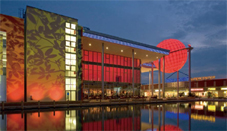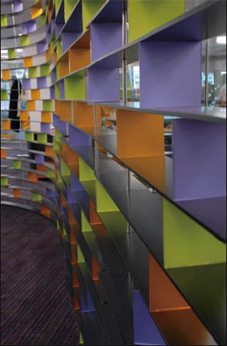
The overall amount of Polymethyl Methacrylate (PMMA) molding compounds and semi-finished products reached approx. 1.5 million tons in 2007. PMMA offers a vast range of applications, which, in the medium term, is expected to increase. Regions will grow at different speeds, though. Growth in the Far East region will be above average, most of all in China, while increase in Europe and NAFTA will be more or les s moderate. The Asia-Paci f ic region i s presently the main consumer accounting for more than 50% of all PMMA produced, followed by Europe (22%) and NAFTA (21%). The major suppliers in Europe are still Evonik Industries, Altuglas International and Lucite International, accounting for almost 40% of global capacities. There are several more suppliers (e.g. Mitsubishi-Rayon, Sumito Chemicals and LG MMA) most of them focusing on regional markets, particularly in Asia. "A substantial share of PMMA is consumed by the construction sector." There were some structural changes among suppliers in the past few years and further changes are anticipated. At the end of 2007, Altuglas International took over the PMMA sheet sector form Repsol, Madrid, Spain. As part of its restructuring program, Lucite International sold to Plaskolite its manufacturing plants for PMMA molding compounds and extruded PMMA sheets in the USA. In May 2008, Lucite International announced that starting 2009, they will be looking for a buyer for the entire business again, as soon as the new Alpha MMA (methyl methacrylate) plant in Singapore has been established. At the 2007 K plastics trade show, Quinn Plastics talked about their plans for a new PMMA sheet production site in England. Capacities in Europe and America are usually expanded by optimizing production processes. Building additional production capacities is mostly done in the economic region of Asia. To meet Asia''s increasing demands, some suppliers invested in new manufacturing capacities. In line with plans, Evonik announced a new integrated methacrylates production facility in Shanghai, China. The PMMA plant was to be the first module to start operation. More modules for polymer and monomer production are scheduled to follow by September 2009. After completion, the world-scale plant will have an annual capacity of roughly 100,000 metric tons of MMA, with its main share planned to serve as a basis for highly refined methacrylate specialties and polymers aimed at applications such as LCD screens, scratch-proof varnishes, sophisticated adhesives and up-to-date interior linings in cars.

Supplies of raw materials There has been no improvement to the raw material market. The costs of PMMA production are subject to the actual prices of energy and petrochemical products, which are necessary to produce MMA itself, or its starting products, e.g. acetone. Since 2003, there has been a severe boost in the prices of acetone and MMA. Additionally, the costs of logistics have increased substantially wooden pallets, for instance, are 45% more expensive today than in 2003. Apart from the difficult cost situation in the raw material sector, there are other factors that intensify competition at the PMMA market. The alarming development in the EUR/USD exchange rate has a severe impact on raw material prices and energy costs, as well as on Euro countries export businesses with the US dollar regions. Regulation amendments ruling e.g. transport make business even more complex. Jus t as before, there is a strong demand pull, exerted by the prospering applications of optoelectronic sin Asia. In Europe, the largest share of PMMA ( i . e . a p p r o x . 2 9%) is consumed by the construction sector. This figure is followed by a rough 21% by lighting and advertising and by the transport and communications sector ( approx. 22%) . The remaining sectors make up approximately 28 %. Processes in progress
Air Jordan XIII High The overall amount of Polymethyl Methacrylate (PMMA) molding compounds and semi-finished products reached approx. 1.5 million tons in 2007. PMMA offers a vast range of applications, which, in the medium term, is expected to increase. Regions will grow at different speeds, though. Growth in the Far East region will be above average, most of all in China, while increase in Europe and NAFTA will be more or les s moderate. The Asia-Paci f ic region i s presently the main consumer accounting for more than 50% of all PMMA produced, followed by Europe (22%) and NAFTA (21%). The major suppliers in Europe are still Evonik Industries, Altuglas International and Lucite International, accounting for almost 40% of global capacities. There are several more suppliers (e.g. Mitsubishi-Rayon, Sumito Chemicals and LG MMA) most of them focusing on regional markets, particularly in Asia. "A substantial share of PMMA is consumed by the construction sector." There were some structural changes among suppliers in the past few years and further changes are anticipated. At the end of 2007, Altuglas International took over the PMMA sheet sector form Repsol, Madrid, Spain. As part of its restructuring program, Lucite International sold to Plaskolite its manufacturing plants for PMMA molding compounds and extruded PMMA sheets in the USA. In May 2008, Lucite International announced that starting 2009, they will be looking for a buyer for the entire business again, as soon as the new Alpha MMA (methyl methacrylate) plant in Singapore has been established. At the 2007 K plastics trade show, Quinn Plastics talked about their plans for a new PMMA sheet production site in England. Capacities in Europe and America are usually expanded by optimizing production processes. Building additional production capacities is mostly done in the economic region of Asia. To meet Asia''s increasing demands, some suppliers invested in new manufacturing capacities. In line with plans, Evonik announced a new integrated methacrylates production facility in Shanghai, China. The PMMA plant was to be the first module to start operation. More modules for polymer and monomer production are scheduled to follow by September 2009. After completion, the world-scale plant will have an annual capacity of roughly 100,000 metric tons of MMA, with its main share planned to serve as a basis for highly refined methacrylate specialties and polymers aimed at applications such as LCD screens, scratch-proof varnishes, sophisticated adhesives and up-to-date interior linings in cars.
The overall amount of Polymethyl Methacrylate (PMMA) molding compounds and semi-finished products reached approx. 1.5 million tons in 2007. PMMA offers a vast range of applications, which, in the medium term, is expected to increase. Regions will grow at different speeds, though. Growth in the Far East region will be above average, most of all in China, while increase in Europe and NAFTA will be more or les s moderate. The Asia-Paci f ic region i s presently the main consumer accounting for more than 50% of all PMMA produced, followed by Europe (22%) and NAFTA (21%). The major suppliers in Europe are still Evonik Industries, Altuglas International and Lucite International, accounting for almost 40% of global capacities. There are several more suppliers (e.g. Mitsubishi-Rayon, Sumito Chemicals and LG MMA) most of them focusing on regional markets, particularly in Asia. "A substantial share of PMMA is consumed by the construction sector." There were some structural changes among suppliers in the past few years and further changes are anticipated. At the end of 2007, Altuglas International took over the PMMA sheet sector form Repsol, Madrid, Spain. As part of its restructuring program, Lucite International sold to Plaskolite its manufacturing plants for PMMA molding compounds and extruded PMMA sheets in the USA. In May 2008, Lucite International announced that starting 2009, they will be looking for a buyer for the entire business again, as soon as the new Alpha MMA (methyl methacrylate) plant in Singapore has been established. At the 2007 K plastics trade show, Quinn Plastics talked about their plans for a new PMMA sheet production site in England. Capacities in Europe and America are usually expanded by optimizing production processes. Building additional production capacities is mostly done in the economic region of Asia. To meet Asia''s increasing demands, some suppliers invested in new manufacturing capacities. In line with plans, Evonik announced a new integrated methacrylates production facility in Shanghai, China. The PMMA plant was to be the first module to start operation. More modules for polymer and monomer production are scheduled to follow by September 2009. After completion, the world-scale plant will have an annual capacity of roughly 100,000 metric tons of MMA, with its main share planned to serve as a basis for highly refined methacrylate specialties and polymers aimed at applications such as LCD screens, scratch-proof varnishes, sophisticated adhesives and up-to-date interior linings in cars.  Supplies of raw materials There has been no improvement to the raw material market. The costs of PMMA production are subject to the actual prices of energy and petrochemical products, which are necessary to produce MMA itself, or its starting products, e.g. acetone. Since 2003, there has been a severe boost in the prices of acetone and MMA. Additionally, the costs of logistics have increased substantially wooden pallets, for instance, are 45% more expensive today than in 2003. Apart from the difficult cost situation in the raw material sector, there are other factors that intensify competition at the PMMA market. The alarming development in the EUR/USD exchange rate has a severe impact on raw material prices and energy costs, as well as on Euro countries export businesses with the US dollar regions. Regulation amendments ruling e.g. transport make business even more complex. Jus t as before, there is a strong demand pull, exerted by the prospering applications of optoelectronic sin Asia. In Europe, the largest share of PMMA ( i . e . a p p r o x . 2 9%) is consumed by the construction sector. This figure is followed by a rough 21% by lighting and advertising and by the transport and communications sector ( approx. 22%) . The remaining sectors make up approximately 28 %. Processes in progressAir Jordan XIII High
Supplies of raw materials There has been no improvement to the raw material market. The costs of PMMA production are subject to the actual prices of energy and petrochemical products, which are necessary to produce MMA itself, or its starting products, e.g. acetone. Since 2003, there has been a severe boost in the prices of acetone and MMA. Additionally, the costs of logistics have increased substantially wooden pallets, for instance, are 45% more expensive today than in 2003. Apart from the difficult cost situation in the raw material sector, there are other factors that intensify competition at the PMMA market. The alarming development in the EUR/USD exchange rate has a severe impact on raw material prices and energy costs, as well as on Euro countries export businesses with the US dollar regions. Regulation amendments ruling e.g. transport make business even more complex. Jus t as before, there is a strong demand pull, exerted by the prospering applications of optoelectronic sin Asia. In Europe, the largest share of PMMA ( i . e . a p p r o x . 2 9%) is consumed by the construction sector. This figure is followed by a rough 21% by lighting and advertising and by the transport and communications sector ( approx. 22%) . The remaining sectors make up approximately 28 %. Processes in progressAir Jordan XIII High













